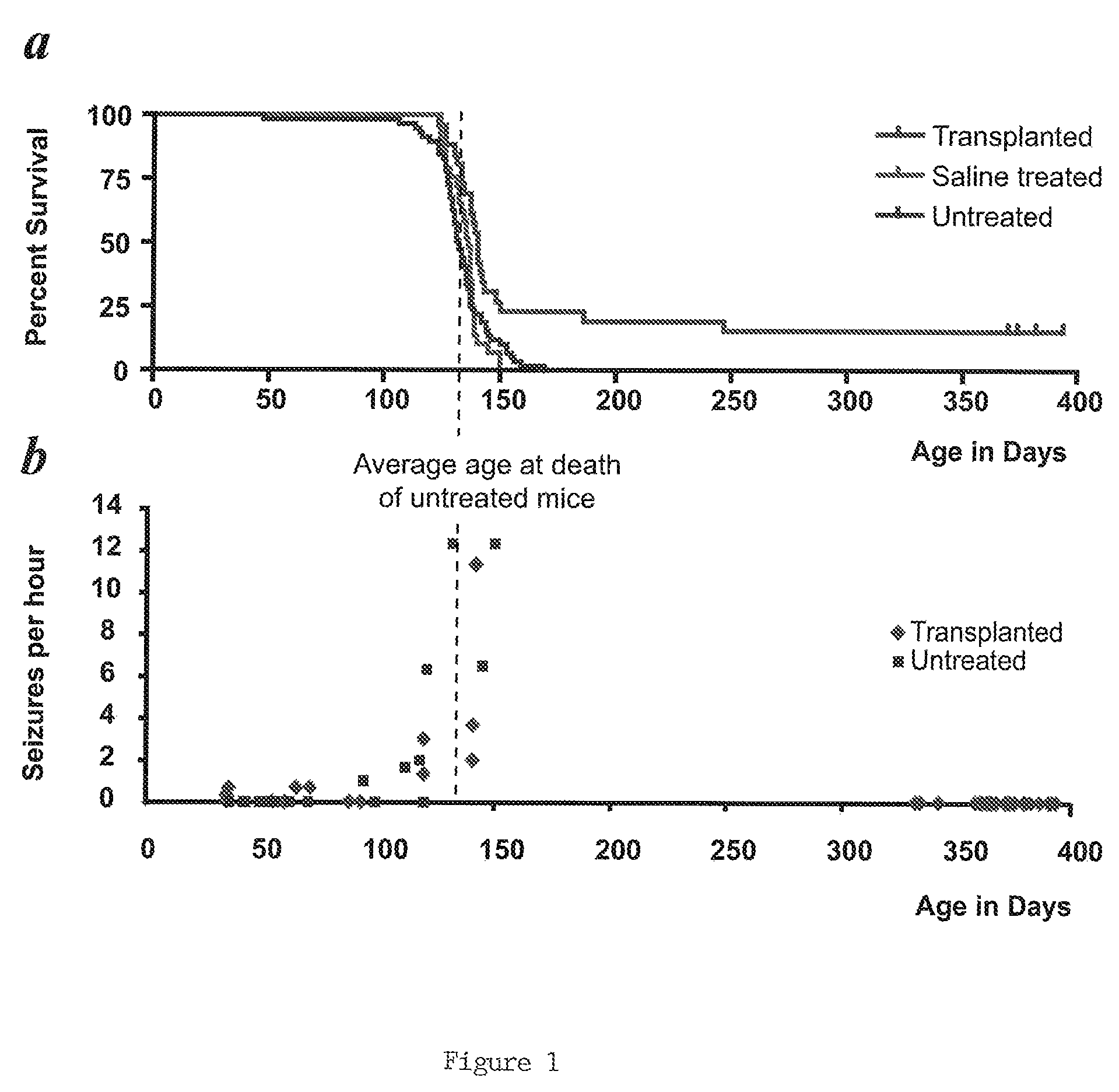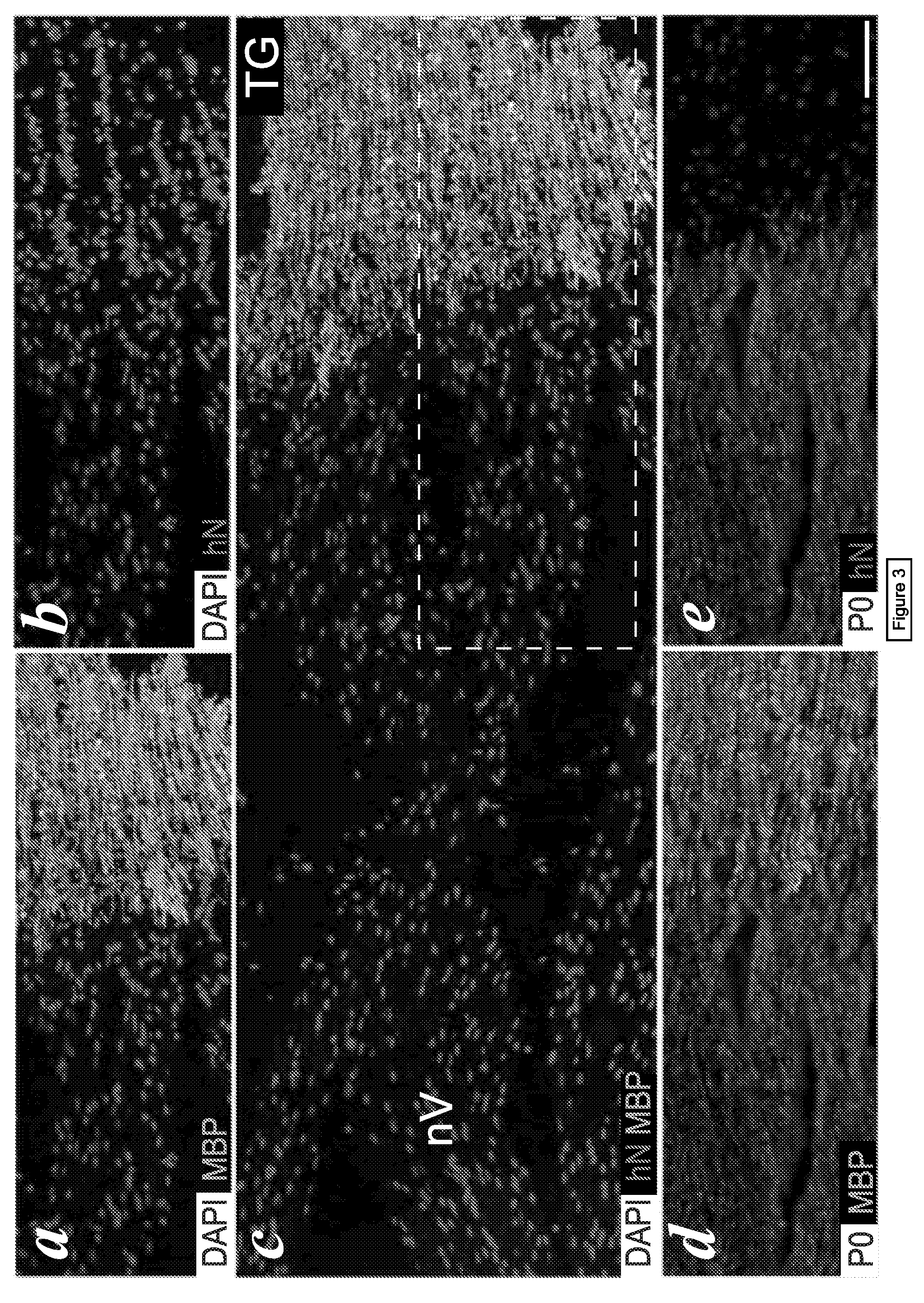Non human animals with human-glial chimeric brains
a technology of glial chimeric brain and human glial chimeric, which is applied in the field of nonhuman animals with human glial chimeric brain, can solve the problems of unclear remyelination strategy, achieve widespread central myelination, influence the phenotype and survival of the recipient animal, and increase the number of glial chimeric cells
- Summary
- Abstract
- Description
- Claims
- Application Information
AI Technical Summary
Benefits of technology
Problems solved by technology
Method used
Image
Examples
example 1
[0063]Fetal oligodendrocyte progenitor cells (“OPCs”) were extracted from second trimester human fetuses (19 to 22 weeks gestational age, g.a.), obtained at abortion as described (Windrem et al., “Fetal and Adult Human Oligodendrocyte Progenitor Cell Isolates Myelinate the Congenitally Dysmyelinated Brain,”Nature Medicine 10:93-97 (2004), which is hereby incorporated by reference in its entirety). The forebrain ventricular / subventricular zones were rapidly dissected from the remaining brain parenchyma, the samples chilled on ice, and the minced samples then dissociated using papain / DNAse as described (Keyoung et al., “Specific Identification, Selection and Extraction of Neural Stem Cells from the Fetal Human Brain,”Nature Biotechnology 19:843-850 (2001), which is hereby incorporated by reference in its entirety), always within 3 hours of extraction. The dissociates were then maintained overnight in minimal media of DMEM / F12 / N1 with 20 ng / ml FGF. A total of 5 tissue s...
example 2
[0064]Sorted glial progenitor cells were isolated from dissociated tissue using a dual immunomagnetic sorting strategy. On the day after dissociation the cells were incubated with mouse anti-PSA-NCAM (Chemicon) at 1:100. then washed and labeled with microbead-tagged rat anti-mouse IgM (Miltenyi Biotech), and removed by MACS depletion. The remaining PSA-NCAM− cells were next incubated 1:1 with MAb A2B5 supernatant (clone 105; ATCC, Manassas, Va.), for 20 minutes, then washed and labeled with microbead-tagged rat anti-mouse IgM (Miltenyi Biotech). All incubations were done on ice (Keyoung et al., “Specific Identification, Selection and Extraction of Neural Stem Cells from the Fetal Human Brain,”Nature Biotechnology 19:843-850 (2001) and Roy et al., “In Vitro Neurogenesis by Progenitor Cells Isolated from the Adult Human Hippocampus,”Nat Med 6:271-7. (2000), which are hereby incorporated by reference in their entirety). Magnetic separation of A2B5+ cells (MACS; Miltenyi) wa...
example 3
Transplantation and Husbandry
[0065]Homozygous shiverers were crossed to homozygous rag2 null immunodeficient mice (Shinkai et al., “RAG2-Deficient Mice Lack Mature Lymphocytes Owing to Inability to Initiate V(D)J Rearrangement,”Cell 68:855-867 (1992), which is hereby incorporated by reference in its entirety), to generate a line of shi / shi×rag2− / − myelin-deficient, immunodeficient mice. Newborn pups of this line were transplanted within a day of birth, using a total of 300,000 donor cells dispersed over 5 injection sites. The pups were first cryoanesthetized for cell delivery. 5×104 donor cells in 0.5 μl HBSS were then injected at each of 4 locations in the forebrain subcortex, specifically into the anterior and posterior anlagen of the corpus callosum bilaterally. These injections were delivered to a depth of 1.0 to 1.2 mm ventrally, depending on the weight / size of the pup (which varied from 1-1.5 g). A fifth injection of 105 cells in 1 μl was delivered into the cerebellar peduncle...
PUM
| Property | Measurement | Unit |
|---|---|---|
| depth | aaaaa | aaaaa |
| body temperature | aaaaa | aaaaa |
| diameter | aaaaa | aaaaa |
Abstract
Description
Claims
Application Information
 Login to View More
Login to View More - R&D
- Intellectual Property
- Life Sciences
- Materials
- Tech Scout
- Unparalleled Data Quality
- Higher Quality Content
- 60% Fewer Hallucinations
Browse by: Latest US Patents, China's latest patents, Technical Efficacy Thesaurus, Application Domain, Technology Topic, Popular Technical Reports.
© 2025 PatSnap. All rights reserved.Legal|Privacy policy|Modern Slavery Act Transparency Statement|Sitemap|About US| Contact US: help@patsnap.com



